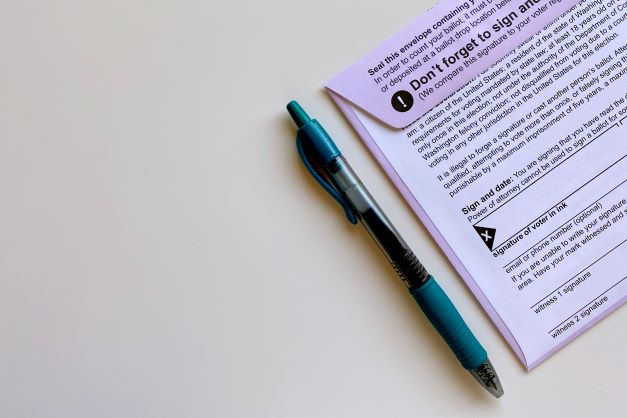by Karim Doumar and Cynthia Gordy Giwa
This story was originally published by ProPublica. ProPublica is a Pulitzer Prize-winning investigative newsroom. Sign up for The Big Story newsletter to receive stories like this one in your inbox.
Series: A User’s Guide to Democracy
Congress Works For You. Here’s How to Be a Better Boss.
Let’s get you ready to cast your ballot by creating a voting plan.
First things first: Have you confirmed your voter registration yet? You’ll need to be registered in order to vote by mail or in person.
All registered to vote? Let’s talk about your options.
See our simple guide to voting here.
Every county has at least a couple of options for casting a ballot — a combination of in-person voting on Election Day and an extended period for early voting, for example. Or maybe there’s expanded access to voting by mail and polling sites where you can cast a ballot in person. Those options will be handled differently depending on where you live because of our patchwork voting system, which has more than 10,000 jurisdictions that all run elections in different ways.
The good news is, the more choices that are offered, the likelier you are to find the one most appropriate for your needs. Here, we’re going to discuss voting options in broad strokes.
Voting Early in Person or on Election Day
Even as many states have expanded the ability to vote by mail, a lot of people prefer to do the job in person. Voters with who have difficult speaking or reading English may require an interpreter to help them with their ballot. Many people are wary about voting in any way other than an in-person system that allows them to see their ballot being physically cast. Some states make it challenging to vote any other way.
There’s a national campaign underway to recruit people to staff polling places during early voting and on Election Day, and you can find information on how to volunteer here.
Most states — 46 in total — offer some kind of early voting. Your secretary of state’s website has more details about the local rules and how many days of early voting you get (if it’s offered). But if you’re able to cast your ballot early in your state and are confident in your choices, consider voting as early as possible.
Here’s one reason: If you go to your polling place and there’s a long line, you can try coming back the next early voting day. But if you put it off until Nov. 8, then you’ll have no choice but to wait it out. That can help ease the Election Day crush for other voters and poll workers.
How to Vote in Person
Prefer to fill out your ballot in person at your polling location? Follow these steps to make a plan to vote in person.
1. Locate your polling place. It might not be where you voted last time. For some of you, your polling site won’t be sorted out until a couple weeks before Election Day. Check out the status of where you’re supposed to vote (and remember to double-check closer to voting time) at your county election official’s website or look it up here.
2. Decide whether to go early or on Election Day. Investigate early voting options at your secretary of state’s website.
3. Figure out if you need ID. If you’re a first-time voter, you are required to show identification at the polls. And in some states, all voters have to present ID. But what you’ll need to bring varies by state. Sometimes drastically. You can check your state’s ID requirements here.
- Strict PhotoID: Some states require voters to show government-issued photo identification, like a driver’s license or U.S. passport.
- Strict Non-Photo ID: In some states, a non-photo ID with your name and address, such as a utility bill or bank statement, is required.
- Non-Strict Voter ID: Some states request either of these forms of ID, but ID is not required for you to vote. Under this category, you can still vote through alternative options like signing an identity affidavit, having election officials vouch for your identity or voting on a provisional ballot that is double-checked by your local election officials. (But, like all things on Nov. 8, your options come down to the state where you’re voting.)
- No Document Required to Vote: Finally, in some states, you don’t have to show any ID at all — unless you’re a first-time voter.
Once you know where and when you’ll vote in person, make sure to allow yourself enough time to travel to your polling location and possibly wait in line if it’s busy.
Voting by Mail
Thirty-five states and the District of Columbia currently allow anyone to vote absentee — that is, vote by mail. In most of those places you have to request an absentee ballot, although several send every registered voter an application for one.
Fifteen states require an excuse to vote by mail. In most of these states, you can still request an absentee ballot if you are going to be out of your county on Election Day, are sick or have a physical disability that makes it hard to get to the polls, are on active duty in the U.S. military or are working a required shift that coincides with polling hours.
See your secretary of state’s website for details on how to get your ballot. If you live in a state where you have to request an absentee ballot, do it now. Election offices are slammed in the weeks before Election Day. And the sooner you request and receive your ballot, the sooner you can send it back.
Voting by mail has proven to be secure and effective.
In all states, voting by mail involves a ballot return deadline. As with practically every other part of the voting process, the absentee ballot deadline varies by state — but the U.S. Postal Service recommends that voters mail their ballot at least one week before the due date required by each state to allow for disruptions like severe weather and other unforeseen circumstances. The earlier you send it, the safer you’ll be.
If you want to bypass the mail, some states have ballot drop-off boxes — a secure, time-tested way to return your ballot. Others let you drop off your absentee ballot at the county election office or your polling place. To check your drop-off alternatives (if any), contact your local election office.
We have all heard again and again false claims of fraudulent mail-in ballots, stuffed ballot boxes and other outlandish statements meant to break our trust in election results. But cases of fraudulent voting are exceptionally rare.
How to Vote by Mail
1. Check the deadlines for requesting and submitting a ballot. See your secretary of state’s website for details.
2. Find drop-off box locations that might work for you. Contact your local election office to learn about drop-off options for your absentee ballot.
3. Request the ballot! Why wait? The sooner you have your ballot, the sooner you can fill it out and turn it in so your vote can be counted on time.
4. Fill out your ballot. Be sure to follow all instructions for marking your vote and sealing the envelope.
5. Mail in your ballot by the deadline. Try to mail your ballot at least one week before Election Day. Or see if your state has ballot drop-off boxes so you don’t have to worry about it being postmarked on time.
Getting Help Voting — or Helping Others
The right to vote is protected for those who do not know how to read, and the Voting Rights Act entitles people who struggle with literacy to get help casting their ballots. This is also true for people who do not speak English and those with intellectual disabilities.
Our reporters recently dove deep on this in a stunning investigation titled “The Fight Against an Age-Old Effort to Block Americans From Voting.” Here’s what they found:
“For all of the recent uproar over voting rights, little attention has been paid to one of the most sustained and brazen suppression campaigns in America: the effort to block help at the voting booth for people who struggle to read — a group that amounts to about 48 million Americans, or more than a fifth of the adult population. ProPublica analyzed the voter turnout in 3,000 counties and found that those with lower estimated literacy rates, on average, had lower turnout.”
But you can help. Read our report on how to make voting easier, and share our simple guide to voting!
Image:Tiffany Tertipes/Unsplash







































